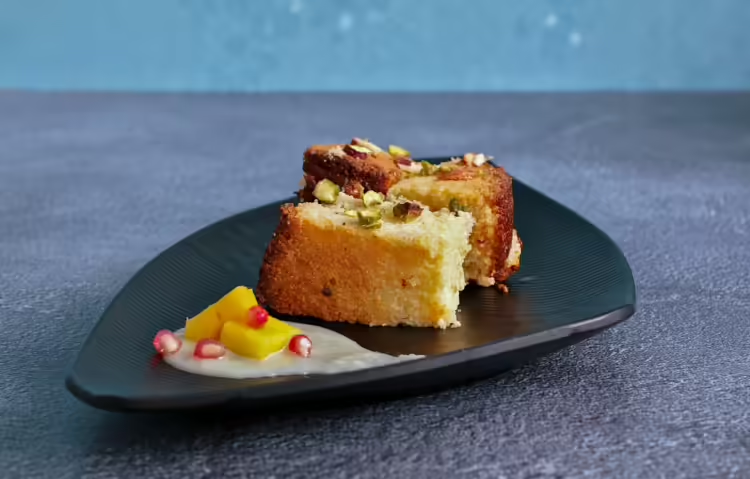The meal of the gods, Chhena Poda
Paneer is referred to be the “National Food of Haryana” by my buddy Sanjay Bhandari. Bengalis also prefer to assert their ownership rights over Chhena. But like their claims about Rosogolla, this allegation amounts to a kind of gastronomic imperialism.

However, even though both Paneer and Chhena are quadrupeds, mentioning them together would be as sacrilegious as comparing a horse and a goat (to paraphrase a famous piece on Bengali cuisine written by the renowned Indian writer, Buddhadev Bose).
Paneer and Chhena have comparable chemical compositions. Both are basically uncultured, soft cottage cheeses made mostly of casein that is separated from milk by coagulation and curdling. However, the nature of the final product and the method used make a difference. Chhena is formed by just removing the whey, but it still has some moisture in it, which causes it to crumble easily. To make paneer solid, it undergoes further processing to remove all of the water. In order for Paneer to be chopped into little bits. Chhena, on the other hand, has to be formed into balls or have ingredients like semolina added to it to make it harder. Since cow’s milk is often used to make chhena, it contains little fat. Paneer has extra fat since it is derived from full-fat Buffalo milk.
Paneer is produced from curd, which gives it a creamier texture, while Chhena is created with milk that has been curdled with lemon or lactic acid. Paneer is more adaptable and may be eaten in a number of ways and prepared in different ways. Its shelf life is also greater. However, because of its increased moisture content, chhena is employed in fewer dishes and must be eaten considerably sooner. Bengalis sometimes give it to infants and recovering patients as a protein source when combined with sugar. It is regarded as a health food by Weight Watchers.
It is said that paneer has been around since the Vedic era and that the Indus Valley civilization’s inhabitants were aware of it. Sonal Ved, the author of the book Whose Samosa is it anyway?, claims that the Turkish term Peynir is where the name Paneer first appeared.
It is said that chena, in its current form, was introduced to Bengal by Portuguese settlers who arrived in the Bandel district, which is a little north of Kolkata. From there, it spread to other regions of eastern India. Ved disagrees with this hypothesis, but I’ll stake my claim. Initially, they taught the locals how to make cheese the Dutch method. This gave rise to what is possibly the only native Indian cheese, known as bandel cheese. However, we’ll save it for an other day. Later on, chhena transformed into a cottage cheese and was included into the regional dishes. Eventually, it became well-known in modern-day Odisha outside Bengal, setting the stage for the Battle of Rosogolla.
However, the round balls of Chhena dipped in gur or sugar syrup are not the protagonist of this story. Chenna Poda is a lesser-known Odia sweet that was, until recently, almost unknown outside of the state. Nonetheless, it is said to have originated more recently than the Rosogolla, which dates back to the start of the Jagannath cult in the fifteenth century AD. In Dashapalla, close to Puri, confectioner Sudarshan Sahu made the accidental discovery of Chhenna Poda in 1947.
All the makings of a classic, however, and it might easily pass for the feast of gods. I won’t bore the kind readers with the gory details of Chhena Poda’s story—they can readily find it online.
The informed associate this baked treat with Basque Cheesecake. Nonetheless, I believe that Chhena Poda, which is really exceptional and has a distinct personality, is unfairly compared to this. Chena Poda has to be created using freshly made Chhena (not commercially manufactured material), which is baked for many hours until it browns after being well kneaded with sugar and semolina and flavored with cardamom, cashew nuts, and raisins. The caramelized sugar is really where the flavor comes from. It may be compared to the baked Kalakand, which is offered as Milk Cake in North India. Nothing compares to the exquisite Chhenna Poda, despite Bengalis’ best efforts to compete with Baked Sandesh.
Other desserts with chhena base besides chhena poda include chhena gaja, rasabali, and chhena jilli. I disregarded my diabetologist’s advice and gave in to the temptation of sampling them all last week while on a flight to Balasore. My defense was that each one was worth dying for.
Odia candies are often underappreciated and inadequately advertised. There has been a recent push to make Chhena Poda more well known. April 11, the day of Sudarshan Sahu’s birth, has been designated as “World Chhena Poda” Day. Nayagarh District has already filed for a GI Tag for Chhena Poda. That was a wise choice. Odisha would do better to introduce the world to Chhena Poda, its real original innovation, than to continue waging a losing war over Rosogolla.







